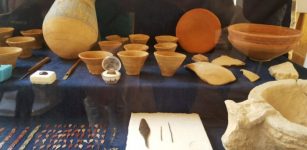Paris Point Zero And The Mysterious Statue Of Monsieur Legris
Ellen Lloyd - AncientPages.com - No one knows exactly when the statue first appeared in Paris, but it’s believed it was raised in pre-Roman times. Sometime during the 12th and 13th centuries, people started to call the statue “Monsieur Legris”, but the origin of the name remains a historical mystery. Bad weather and pollution turned the statue gray and perhaps this is the reason why the unknown man became known as monsieur Legris. In French, “le gris” means “gray” and the old statue did have a gray appearance.
Who built the statue of Monsieur Legris? Image credit: Wander Stories
Who was monsieur Legris really and why did someone build a statue of him such a long time ago? Was he an ancient god, a saint, an alchemist, a member of a secret society, or someone else? Obviously, whoever he was, he must have been of great importance to people. For as long as we can remember, monsieur Legris has pointed pilgrims their way to the Notre Dame Cathedral, and yet, his identity remains a mystery. Many have tried to unravel the mystery of monsieur Legris, but no one knows the truth and there are only theories attempting to explain who this enigmatic individual could have been.
Paris Point Zero Measures All Distances
There is an old saying that all roads lead to Rome, but if you visit Paris, you can find a small geographic marker from which all distances in France are measured from the exact center of Paris.
The place is called Paris Point Zero and it was laid in 1924. Despite its significance, many are unaware of its existence. Point Zero is just outside the Notre Dame Cathedral, one of many magnificent buildings in Paris. The Point Zero marker is neither very famous nor especially eye-catching, so it’s no surprise many have never heard of it. In fact, one can easily pass it without even noticing the octagonal brass plate in the paving stone.
Paris Zero Point. Credit: Public Domain, CC BY-SA 3.0
Today, Point Zero is associated with good luck. It’s believed that if you place a foot on the circle, you can have a wish fulfilled. Many couples stand here and kiss because they think the plate ensures eternal devotion and love. Another belief is that tourists who stand on the marker will return to Paris, which is a dream destination for many who visit Europe.
Who Was Mysterious Monsieur Legris?
Returning back to those days when monsieur Legriss was present here, and before the creation of the marker Zero Point, we learn that the statue standing on this particular spot was made in the image of a man holding a book and a snake. This has led some researchers to suggest the statue depicted the Greek God Asclepius. According to the Greek myths, Asclepius learned the art of healing from both his father Apollo and the centaur Cheiron. In time, he became so skilled in surgery and the use of drugs that he was revered as the founder of medicine.
The Rod of Asclepius, also known as the Staff of Asclepius, a serpent-entwined rod wielded by the Greek god Asclepius is today associated with medicine and health care. This is why a snake is a symbol of medicine, but it’s often confused with the staff of the god Hermes, the caduceus.
Other researchers and historians speculated monsieur Legris could have been Jesus, Guillaume de Paris, St. Geneviève, or the Roman God Terminus who protected boundary markers.
Left: Bowl of Hygieia. Middle: Rod Of Asclepius. Right: Greek God Asclepius - Credit: Public Domain
Another possibility is that that statue was somehow related to alchemists. During the Renaissance and the Reformation, Hermeticism played an important role in the Western world. Based on the writing of attributed to Hermes Trismegistus, many became interested in the religious, philosophical, and esoteric tradition.
Being treated as heretics by the Catholic Church, it was necessary for followers of Hermeticism to conceal their secret and divine knowledge using alchemy symbols and metaphors.
Could Monsieur Legris have been a depiction of Hermes Trismegistus, who the ancient Greeks identified with the Egyptian god Thoth? Maybe, this is the case, but it seems unlikely. In 1625, a fountain was built next to the statue. An inscription written in Latin on the statue read, translated: Approach those of you who are altered, and if by chance my waters are not enough, go to the temple and the goddess you invoke will prepare eternal waters for you.”
Who was this mentioned goddess? Could it have been Virgin Mary or was it just a reminder to Christians that they should pray and fast?
We may never the truth behind the statue of Monsieur Legris and his identity remains a secret. In 1748, his statue was destroyed and removed because there was a need to enlarge the square. Instead, the Point Zero marker was placed on the same spot.
Updated on June 12, 2022
Written by Ellen Lloyd – AncientPages.com
Copyright © AncientPages.com All rights reserved. This material may not be published, broadcast, rewritten or redistributed in whole or part without the express written permission of AncientPages.com
Expand for referencesMore From Ancient Pages
-
 Extraordinary Etruscan And Roman Treasure Trove Unearthed In San Casciano dei Bagni, Italy
Archaeology | Aug 12, 2022
Extraordinary Etruscan And Roman Treasure Trove Unearthed In San Casciano dei Bagni, Italy
Archaeology | Aug 12, 2022 -
 New Discoveries In the Valley Of The Monkeys In Luxor, Egypt
Archaeology | Oct 11, 2019
New Discoveries In the Valley Of The Monkeys In Luxor, Egypt
Archaeology | Oct 11, 2019 -
 Amanirenas – Fearless Queen Of Kush Who Defeated Ancient Romans
Featured Stories | Jan 30, 2019
Amanirenas – Fearless Queen Of Kush Who Defeated Ancient Romans
Featured Stories | Jan 30, 2019 -
 Clay Tablets Of Assyrian ‘King Of The World’ Esarhaddon Found Beneath Biblical Tomb Of Jonah
Archaeology | Mar 1, 2018
Clay Tablets Of Assyrian ‘King Of The World’ Esarhaddon Found Beneath Biblical Tomb Of Jonah
Archaeology | Mar 1, 2018 -
 1,400-Year-Old Iron Hammer And Nails Among Findings At Sanhedrin, Western Galilee’s Usha
Archaeology | Nov 6, 2019
1,400-Year-Old Iron Hammer And Nails Among Findings At Sanhedrin, Western Galilee’s Usha
Archaeology | Nov 6, 2019 -
 Enigmatic Ancient ‘Unknown Kushan Script’ Deciphered By Scientists
Archaeology | Jul 13, 2023
Enigmatic Ancient ‘Unknown Kushan Script’ Deciphered By Scientists
Archaeology | Jul 13, 2023 -
 Ancient City Machu Picchu Was Originally Called Huayna Picchu By The Incas – Study Of The Name Reveals
Archaeology | Mar 23, 2022
Ancient City Machu Picchu Was Originally Called Huayna Picchu By The Incas – Study Of The Name Reveals
Archaeology | Mar 23, 2022 -
 Scientists Found Mysterious Prophecies In Ancient Egyptian Pyramid – Are They Linked To The Strange Visions Some Experience Inside?
Featured Stories | Dec 17, 2024
Scientists Found Mysterious Prophecies In Ancient Egyptian Pyramid – Are They Linked To The Strange Visions Some Experience Inside?
Featured Stories | Dec 17, 2024 -
 Ancient Sophisticated Technologies: Mercury-Based Gilding That We Still Can’t Reach
Ancient Technology | Aug 1, 2018
Ancient Sophisticated Technologies: Mercury-Based Gilding That We Still Can’t Reach
Ancient Technology | Aug 1, 2018 -
 Secrets Of Benjamin Franklin’s Paper Money Deciphered By Scientists
Archaeology | Jul 18, 2023
Secrets Of Benjamin Franklin’s Paper Money Deciphered By Scientists
Archaeology | Jul 18, 2023 -
 Mystery Of The Ancient Unknown Mining Civilization In North America – Connecting the Dots – Part 2
Civilizations | Apr 23, 2022
Mystery Of The Ancient Unknown Mining Civilization In North America – Connecting the Dots – Part 2
Civilizations | Apr 23, 2022 -
 On This Day In History: Viking Forces Laid Siege To Paris – On Nov 25, 885
News | Nov 25, 2016
On This Day In History: Viking Forces Laid Siege To Paris – On Nov 25, 885
News | Nov 25, 2016 -
 Ancient Giants In Ecuador Were Killed By Fire From The Sky – Indian Legends Reveal
Featured Stories | Dec 12, 2017
Ancient Giants In Ecuador Were Killed By Fire From The Sky – Indian Legends Reveal
Featured Stories | Dec 12, 2017 -
 Previously Unknown Manuscript Reveals New Insight Into Medieval Christian Beliefs In England
Archaeology | Oct 26, 2021
Previously Unknown Manuscript Reveals New Insight Into Medieval Christian Beliefs In England
Archaeology | Oct 26, 2021 -
 Mabon Festival And The Autumn Equinox Celebrated By Pagans
Ancient Traditions And Customs | Sep 19, 2024
Mabon Festival And The Autumn Equinox Celebrated By Pagans
Ancient Traditions And Customs | Sep 19, 2024 -
 Ancient Manuscript In Museum Reveals Discovery Of Objects Unknown To Modern Science – Why Were The Ancient Time Capsules Hidden? – Part 3
Featured Stories | Apr 14, 2021
Ancient Manuscript In Museum Reveals Discovery Of Objects Unknown To Modern Science – Why Were The Ancient Time Capsules Hidden? – Part 3
Featured Stories | Apr 14, 2021 -
 Human DNA Shaped By Past Events Caused Sharp Dips In The Population
News | Jun 27, 2022
Human DNA Shaped By Past Events Caused Sharp Dips In The Population
News | Jun 27, 2022 -
 Ancient City Of Metsamor – Captured And Destroyed By Argishti I, The Ruler Of Urartu
Civilizations | Sep 11, 2015
Ancient City Of Metsamor – Captured And Destroyed By Argishti I, The Ruler Of Urartu
Civilizations | Sep 11, 2015 -
 Mighty Viking Harald Hardrada – The Last Great Viking And Most Feared Warrior Of His Time
Featured Stories | Jun 9, 2020
Mighty Viking Harald Hardrada – The Last Great Viking And Most Feared Warrior Of His Time
Featured Stories | Jun 9, 2020 -
 Significance Of Secret And Powerful Number 108 That Has Accompanied Humankind For Thousands Of Years
Ancient Symbols | Jun 19, 2017
Significance Of Secret And Powerful Number 108 That Has Accompanied Humankind For Thousands Of Years
Ancient Symbols | Jun 19, 2017



